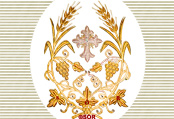|
Anaphoras: The Book of
Divine Liturgies
 Preface
Preface
 Introduction
Introduction
Order of the Liturgy
 Mawrbo
Mawrbo
 Preparatory Order
Preparatory Order
 Public Celebration
Public Celebration
 Kiss of Peace
Kiss of Peace
 Supplications
Supplications
Anaphoras
 St. James
St. James
 St. Mark
St. Mark
 St. Peter
St. Peter
 Twelve Apostles
Twelve Apostles
 St. John
St. John
 St. Xystus
St. Xystus
 St. Julius
St. Julius
 St. John Chrysostom
St. John Chrysostom
 St. Cyril
St. Cyril
 St.
Jacob of Sarugh St.
Jacob of Sarugh
 St. Philoxenus
St. Philoxenus
 St. Severius
St. Severius
 Mar Bar Salibi
Mar Bar Salibi
Appendix
 Supplication to
Supplication to
Virgin Mary
 Consecration of
Consecration of
Vestments/Vessels
 Purification of Altars
Purification of Altars
 Blessing of Icons
Blessing of Icons
 For the Sick
For the Sick
 Repentance Repentance
|
|
© Syrian Orthodox
Dioceses of North America and Canada. Reproduced with permission. No part
of the material may be reproduced in any form or by any means, without
written permission from the publisher.
Of all the seven sacraments, the Holy Eucharist is the greatest and most
exalted, for the true doctrine of the Church teaches us that when the
priest repeats the Lord's words, "This is My Body and this is My
Blood of the New Testament," (Matthew 26:26-28),
as he celebrates the Holy Liturgy and calls down the Holy Spirit, we believe
and confess that our Lord and God Jesus Christ is present in the form
of the bread and wine that are set on the altar before the priest.
We therefore believe and acknowledge that by receiving the Holy Eucharist,
we truly eat the Flesh and drink the Blood of our Savior Jesus Christ
for eternal life that we may dwell in Him, and He in us. Jesus said to
them: "Truly, truly I say to you, unless you eat the Body of the
Son of man and drink His Blood, you have no life in yourselves. He who
eats of My Body and drinks of My Blood has eternal life; and I will raise
him at the last day. For My Body truly is the food, and My Blood truly
is the drink. He who eats My Body and drinks My Blood abides with Me,
and I in him," (John 6:53-56).
General Exhortations
- The priest must take care that the margonyotho, i.e., the particles
of the Holy Body sprinkled with the Atoning Blood, should be carefully
preserved in a special small chalice gilded on the inside. The chalice
must be set in a tabernacle fixed on the altar and set up in the center
of the sanctuary. The door of the tabernacle must be kept locked.
- In accordance with our ecclesiastical tradition, the bread to be consecrated
for Holy Liturgy is a flat cake made of wheat dough mixed with a small
portion of leaven and salt and is imprinted with a special seal. On
preparing the dough, the priest, in keeping with the ancient tradition
of our Church, uses as yeast a part of the dough used for baking the
bread for Liturgy the previous time. This is another expression of the
oneness and unity of the sacrament of Communion offered in our churches
all over the world from the apostolic times.
- The priests must diligently urge the faithful to partake of the Holy
Eucharist on Sundays and on the festivals of our Lord. Above all, they
must take great care that the canons of the Church are diligently observed.
Such canons put under anathema all Christians of age if they do not
confess their sins at least once a year and partake of the Holy Eucharist
at least one time, on Maundy Thursday.
- The faithful who wish to receive the Holy Eucharist and have committed
sins must confess their sins to the priests that, with purity of soul,
they may be worthy to partake of the Holy Eucharist.
- The faithful who wish to receive the Holy Eucharist must observe a
complete fast of three hours prior to the time of the partaking of the
Holy Eucharist.
- The priests are strictly forbidden to administer Communion to all
those who are under anathema or suspensions or to unbelievers unless,
first of all, they openly acknowledge the Orthodox faith and become
in full communion with the Holy Church. Likewise, the Holy Mysteries
are not to be administered to offenders whose transgressions are publicly
known unless they, first of all, truly and earnestly repent of their
sins and unless their true remorse is known to the congregation of the
faithful.
|
|
|

